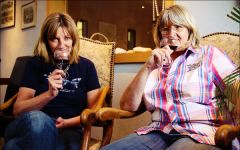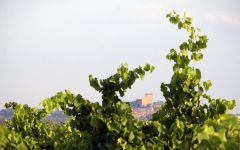Domaine de Marcoux Chateauneuf-du-Pape Blanc 2017
-
Jeb
Dunnuck -
Robert
Parker



Product Details
Your Rating
Somm Note
Winemaker Notes
Professional Ratings
-
Jeb Dunnuck
One of the finest whites I’ve tasted from this estate is the 2017 Châteauneuf-du-Pape Blanc, which is two-thirds Roussanne and one-third Bourboulenc that has malo blocked and is raised in neutral demi-muids and tank. Full-bodied, rich, beautifully textured, and perfectly balanced, it has everything in the right places and just glides over the palate. Giving up plenty of white fruits, brioche, honeysuckle, and some buttered citrus notes, it’s a brilliant effort and well worth seeking out.
-
Robert Parker's Wine Advocate
Hints of honeyed toast mark the nose of the 2017 Chateauneuf du Pape Blanc. A fifth of the wine fermented and aged in demi-muid, while the rest was in stainless steel. Full-bodied, round, soft and rich with peach and pineapple fruit, it comes together on the finish into lime-like precision.
Other Vintages
2021-
Jeb
Dunnuck -
Robert
Parker -
Wine
Spectator
- Decanter
-
Jeb
Dunnuck -
Robert
Parker
-
Jeb
Dunnuck - Vinous
-
Jeb
Dunnuck - Vinous
-
Robert
Parker
-
Jeb
Dunnuck -
Robert
Parker
-
Robert
Parker





In 1990, the Domaine became the first in the Chateauneuf-du-Pape to implement biodynamic farming practices. Their youngest vines are 40 to 60-years-old, and in short, the sisters do as little as possible to the harvested grapes. This domaine, as critic Stephen Tanzer put it, is "the essence of Chateauneuf-du-Pape."
In 2003, Robert Parker named Sophie and Catherine on his list of "Wine Personalities of Year," writing, "Over the last 12 years, the biodynamically farmed vineyard has risen to the top of Chateauneuf-du-Pape's quality hierarchy. The two red wines produced have been stunning, with the regular cuvée of Chateauneuf-du-Pape one of the finest in the appellation, and the limited production Cuvée Vieilles Vignes one of the world’s truly magnificent wines."

Full-bodied and flavorful, white Rhône blends originate from France’s Rhône Valley. Today these blends are also becoming popular in other regions. Typically some combination of Grenache Blanc, Marsanne, Roussanne and Viognier form the basis of a white Rhône blend with varying degrees of flexibility depending on the exact appellation. Somm Secret—In the Northern Rhône, blends of Marsanne and Roussanne are common but the south retains more variety. Marsanne, Roussanne as well as Bourboulenc, Clairette, Picpoul and Ugni Blanc are typical.

Famous for its full-bodied, seductive and spicy reds with flavor and aroma characteristics reminiscent of black cherry, baked raspberry, garrigue, olive tapenade, lavender and baking spice, Châteauneuf-du-Pape is the leading sub-appellation of the southern Rhône River Valley. Large pebbles resembling river rocks, called "galets" in French, dominate most of the terrain. The stones hold heat and reflect it back up to the low-lying gobelet-trained vines. Though the galets are typical, they are not prominent in every vineyard. Chateau Rayas is the most obvious deviation with very sandy soil.
According to law, eighteen grape varieties are allowed in Châteauneuf-du-Pape and most wines are blends of some mix of these. For reds, Grenache is the star player with Mourvedre and Syrah coming typically second. Others used include Cinsault, Counoise and occasionally Muscardin, Vaccarèse, Picquepoul Noir and Terret Noir.
Only about 6-7% of wine from Châteauneuf-du-Pape is white wine. Blends and single-varietal bottlings are typically based on the soft and floral Grenache Blanc but Clairette, Bourboulenc and Roussanne are grown with some significance.
The wine of Chateauneuf-du-Pape takes its name from the relocation of the papal court to Avignon. The lore says that after moving in 1309, Pope Clément V (after whom Chateau Pape-Clément in Pessac-Léognan is named) ordered that vines were planted. But it was actually his successor, John XXII, who established the vineyards. The name however, Chateauneuf-du-Pape, translated as "the pope's new castle," didn’t really stick until the 19th century.
